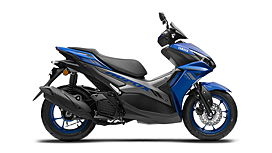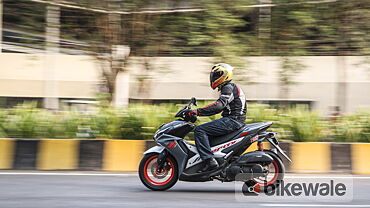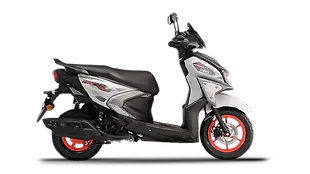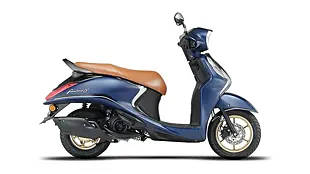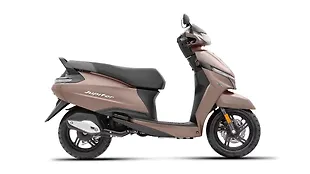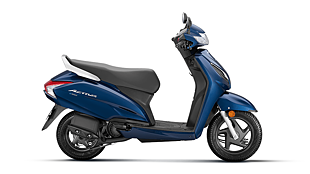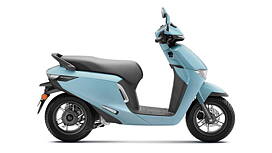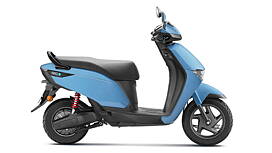Introduction

The Yamaha Aerox is a bit of an anomaly in the Indian scooter market. For a nation that buys scooters as a one-stop solution to commute, go grocery shopping or haul two or sometimes three people, the Aerox doesn’t tick any of those boxes. It still managed to sell in good numbers, enough to even take Yamaha by surprise. Cut to 2024 and we have the Aerox Version S with us for a brief test. As it turns out, there are some changes for the good.
The visuals
Visually, however, nothing much has changed. The Aerox continues to look sporty, youthful and distinct amongst a sea of conservatively styled “family” scooters. The twin LED headlights with the LED DRL brow or the X-shaped central spine and the sportbike-like tail section with the thin strip LED light are what give the Aerox its sports maxi-scooter flair. Even after being around for close to three years, the Aerox looks fresh.

One way to distinguish this scooter from the rest of the Aeroxs is the ‘Version S’ sticker on the central spine. The blue colour of the scooter is something that I like and I have to say that the fit and finish levels are fantastic almost everywhere, save for a few plastics, like the lid that covers the fuel cap.

The package
The Aerox Version S gets a smart key or in other words, a remote key fob like you would on a premium two-wheeler. A rotary knob replaces the ignition keyhole and turning it to dedicated positions allows you to open the boot or the fuel filler cap as well as turn on the ignition. This adds a huge level of convenience to the rider as one doesn’t need to take the key out of the pocket to lock or unlock the scooter as well as turn it on.

Powering the scooter is a 155cc, liquid-cooled, single-cylinder engine that makes 15bhp and 13.9Nm. The engine is now E20-compatible and is paired with a CVT.

The scooter’s reverse LCD packs a lot of information and also gets Bluetooth connectivity. While the amount of information is welcome, I wished for a brighter LCD since it was difficult to read the display when the sun was overhead.

Also, it is about time that Yamaha offered a rear brake lock and a lockable glove box to add to the convenience and safety quotient of the Aerox.
That said, the ride experience makes up for it and some of the changes in this department were the need of the hour.
The Ride
Let’s get one thing straight, the Aerox 155’s engine is an absolute gem. It revs nicely, feels punchy and the refinement levels are pretty good for the most part. It’s only when the revs are approaching the redline that you feel a little buzz in the floorboard and handlebar, but I’m only nitpicking at this point.

In fact, at cruising speeds in the city or 100kmph on the highway, the engine feels effortless and buttery smooth. Pulling quick overtakes or shooting off the traffic light is equally entertaining and there is no denying that this is a fun scooter.

But the biggest issue that has plagued the Aerox 155, ever since its launch is the hard ride, especially at the rear. The stiffness of the spring was such that you’d feel the steps in poorly laid out patchwork in the road or big bumps and potholes. Yamaha has addressed this to some extent in the Version S.
At slow speeds, say while riding in the city at say 50-60kmph, the ride felt more pliant and absorbent. The rear suspension rounded off bumps and large steps in the road quite well and most riders will appreciate this. That said, the front end feels soft and thuds through medium-sized bumps quite easily.

Yamaha seems to have simply responded to customer complaints about a stiff ride by softening it. While it works for the most part, some members of the team were unhappy about the quickened rebound of the rear spring.
All said, for most of the riding that one will do, the Aerox has gotten more comfortable. This, thankfully, has not ruined the stellar handling of the scooter. It still feels planted and involving around a corner and even the new Ceat tyres offer enough grip.
The one area where Yamaha could make an improvement is braking. The front disc rear drum setup is decent at best but I’d wish for a stronger bite and feel from the front disc. Perhaps, adding a disc brake at the rear could solve this problem to some extent. That said, the safety net of ABS that the Aerox comes with is more than welcome.

I also appreciate the presence of a traction control system on the scooter. You may think that TC in a 15bhp scooter is overkill but given the unpredictability of our roads, with gravel, sand and what have you; I’d be glad if TC had my back and kept me from landing my back on the road.
Should you buy it?
The Yamaha Aerox 155 Version S at Rs 1.47 lakh is not cheap by scooter standards. That said, it carves a niche for itself with its styling, engine performance and sweet handling. Not to mention, the convenience of the remote key fob and the air of premiumness it brings to the table.

The Yamaha Aerox 155 is clearly for those who want a scooter that isn’t run of the mill and want something stylish and fun to ride, with the backing and reliability of a Japanese manufacturer. If the outright practicality of a regular scooter is something you don’t need, the Aerox checks many other boxes to make you add it to the scooter shopping list.
Images by Kaustubh Gandhi
Gallery
1/17
Yamaha Aerox 155 Seat
Double Tap to Zoom















